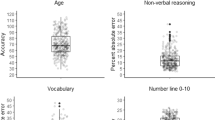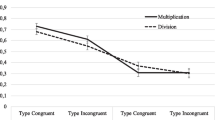Abstract
Estimation supports the development of higher level mathematical thinking and reasoning; however, has received relatively little research attention. We examined whether making predictions influences the accuracy of numerosity estimates in elementary-aged children, and whether the amount of information available to the estimator determines the accuracy of their subsequent estimate. The study was conceptualized on the basis of five different conditions for estimating, based on the contention that estimates will become more accurate as additional information becomes available to the estimator. To test this idea, the study utilized two tasks to examine the responses of year 2 (grade 2) and year 6 (grade 6) students (n = 110) when using prediction-first and estimation-only strategies. Across both tasks, we found a direct linear relationship between the accuracy of students’ estimates and the amount of information available. Moreover, there was some evidence that being given an opportunity to make an initial prediction improved the accuracy of final estimates; however, these conclusions were tempered by task and age. Overall, our findings support a strategy sophistication effect, whereby the amount of information available to the estimator, and the ability to use that information effectively, increases the accuracy of the estimate.







Similar content being viewed by others
Notes
To be consistent with the estimation literature, we refer to the term “decomposition” throughout this paper when discussing this idea, however within the mathematics education literature more broadly, the term multiplicative partitioning or equipartitioning would be considered more accurate.
Note that condition 5 was not considered in the current study. Indeed, in the context of the sorts of tasks we explored with our participants, condition 5 remains essentially theoretical, as attempting to enact it would restructure the task in a manner that would undermine the flow of the interview, and actually change the nature of the task (e.g., moving from beans to cube-shaped beans).
References
Alvarez, J., Abdul-Chani, M., Deutchman, P., DiBiasie, K., Iannucci, J., Lipstein, R., & Sullivan, J. (2017). Estimation as analogy-making: Evidence that preschoolers’ analogical reasoning ability predicts their numerical estimation. Cognitive Development, 41, 73–84.
Anobile, G., Cicchini, G. M., & Burr, D. C. (2016). Number as a primary perceptual attribute: A review. Perception, 45(1–2), 5–31.
Australian Curriculum and Assessment Authority (ACARA). (2015). The Australian Curriculum: Mathematics. Retrieved from: http://www.australiancurriculum.edu.au/mathematics/curriculum/f-10?layout=1.
Baroody, A. J., & Gatzke, M. R. (1991). The estimation of set size by potentially gifted kindergarten-age children. Journal for Research in Mathematics Education, 22(1), 59–68.
Booth, J. L., & Siegler, R. S. (2006). Developmental and individual differences in pure numerical estimation. Developmental Psychology, 42(1), 189–201.
Brod, G., Hasselhorn, M., & Bunge, S. A. (2018). When generating a prediction boosts learning: The element of surprise. Learning and Instruction, 55, 22–31.
Case, R., & Sowder, J. T. (1990). The development of computational estimation: A neo-Piagetian analysis. Cognition and Instruction, 7, 79–104.
Charles, R. I., & Carmel, C. (2005). Big ideas and understandings as the foundation for elementary and middle school mathematics. Journal of Mathematics Education, 7(3), 9–24.
Clarke, D., Cheeseman, J., Gervasoni, A., Gronn, D., Horne, M., McDonough, A., . . . Clarke, B. (2002). Early numeracy research project final report. Melbourne: Australian Catholic University.
Crites, T. (1992). Skilled and less skilled estimators’ strategies for estimating discrete quantities. The Elementary School Journal, 92(5), 601–619.
Downton, A., & Sullivan, P. (2017). Posing complex problems requiring multiplicative thinking prompts students to use sophisticated strategies and build mathematical connections. Educational Studies in Mathematics, 95(3), 303–328.
Gandini, D., Lemaire, P., & Dufau, S. (2008). Older and younger adults’ strategies in approximate quantification. Acta Psychologica, 129(1), 175–189.
Ganor-Stern, D. (2016). Solving arithmetic problems approximately: A developmental perspective. PLoS One, 11, e0155515.
Hegarty, M., Kriz, S., & Cate, C. (2003). The roles of mental animations and external animations in understanding mechanical systems. Cognition and Instruction, 21(4), 209–249.
Huntley-Fenner, G., & Cannon, E. (2000). Preschoolers’ magnitude comparisons are mediated by a preverbal analog mechanism. Psychological Science, 11(2), 147–152.
Kahneman, D., & Egan, P. (2011). Thinking, fast and slow (Vol. 1). New York: Farrar, Straus and Giroux.
Kasmer, L. A., & Kim, O. K. (2012). The nature of student predictions and learning opportunities in middle school algebra. Educational Studies in Mathematics, 79(2), 175–191.
Kim, O.-K., & Kasmer, L. (2007). Using “prediction” to promote mathematical reasoning. Mathematics Teaching in the Middle School, 12(6), 294–299.
LeFevre, J. A., Greenham, S. L., & Waheed, N. (1993). The development of procedural and conceptual knowledge in computational estimation. Cognition and Instruction, 11, 95–132.
Lemaire, P., & Lecacheur, M. (2011). Age-related changes in children’s executive functions and strategy selection: A study in computational estimation. Cognitive Development, 26, 282–294.
Lim, K. H., Buendia, G., Kim, O. K., Cordero, F., & Kasmer, L. (2010). The role of prediction in the teaching and learning of mathematics. International Journal of Mathematical Education in Science and Technology, 41(5), 595–608.
Lowrie, T., Logan, T., & Hegarty, M. (2019). The influence of spatial visualization training on students’ spatial reasoning and mathematics performance. Journal of Cognition and Development, 20(5), 729–751.
National Council of Teachers of Mathematics (NCTM). (2000). Principles and standards for school mathematics. Reston, VA: Author.
Opfer, J. E., & Siegler, R. S. (2007). Representational change and children’s numerical estimation. Cognitive Psychology, 55(3), 169–195.
Patahuddin, S. M., Rokhmah, S., & Ramful, A. (2020). What does teaching of spatial visualisation skills incur: An exploration through the visualise-predict-check heuristic. Mathematics Education Research Journal, 32(2), 307–329.
Presmeg, N. (2006). Research on visualization in learning and teaching mathematics. In A. Gutiérrez & P. Boero (Eds.), Handbook of research on the psychology of mathematics education: Past, present, and future (pp. 205–235). Rotterdam: Sense Publishers.
Rittle-Johnson, B., Siegler, R. S., & Alibali, M. W. (2001). Developing conceptual understanding and procedural skill in mathematics: An iterative process. Journal of Educational Psychology, 93(2), 346–362.
Rittle-Johnson, B., & Star, J. R. (2011). The power of comparison in learning and instruction: Learning outcomes supported by different types of comparisons. In J. Mestre & B. Ross (Eds.), Psychology of learning and motivation (Vol. 55, pp. 199–225). Oxford: Elsevier.
Rivera, F. (2011). Toward a visually-oriented school mathematics curriculum: Research, theory, practice, and issues (Vol. 49). Springer Science & Business Media.
Russo, J. (2018). Dynamic estimation: A guided approach to refining student estimates. Australian Primary Mathematics Classroom, 23(3), 4–7.
Siegel, A. W., Goldsmith, L. T., & Madson, C. R. (1982). Skill in estimation problems of extent and numerosity. Journal for Research in Mathematics Education, 13(3), 211–232.
Siegler, R. S., & Booth, J. L. (2005). Development of numerical estimation: A review. In J. Campbell (Ed.), Handbook of mathematical cognition (pp. 197–212). New York: Psychology Press (Taylor & Francis Group).
Smith, H. D. (1999). Use of the anchoring and adjustment heuristic by children. Current Psychology, 18(3), 294–300.
Verschaffel, L., Greer, B., & De Corte, E. (2007). Whole number concepts and operations. In F. Lester (Ed.), Second handbook of research on mathematics teaching and learning (pp. 557–628). Charlotte: Information Age Publishing.
White, R., & Gunstone, R. (1992). Prediction-observation-explanation. In R. White & R. Gunstone (Eds.), Probing understanding (Vol. 4, pp. 44–64). London: The Falmer Press.
Author information
Authors and Affiliations
Corresponding author
Supplementary Information
ESM 1
(DOCX 641 kb)
Rights and permissions
About this article
Cite this article
Russo, J., MacDonald, A. & Russo, T. The Influence of Making Predictions on the Accuracy of Numerosity Estimates in Elementary-Aged Children. Int J of Sci and Math Educ 20, 531–551 (2022). https://doi.org/10.1007/s10763-021-10156-3
Received:
Accepted:
Published:
Issue Date:
DOI: https://doi.org/10.1007/s10763-021-10156-3




